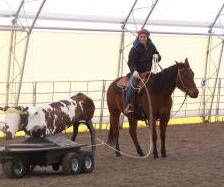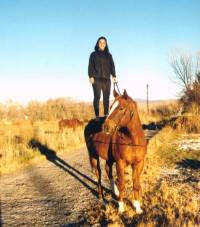 Have you ever worked with a horse who "just wants to get it over with"? In other words, as you are working with the horse on a particular exercise, he rushes through it quickly so he can be done and be turned back out to pasture. Sound familiar?
Have you ever worked with a horse who "just wants to get it over with"? In other words, as you are working with the horse on a particular exercise, he rushes through it quickly so he can be done and be turned back out to pasture. Sound familiar?Those are the actions of a reactive horse, not a thinking horse. Yikes!
Those kinds of horses scare me because I know that if I ever get in a jam with that kind of horse, he's going straight into his "fight or flight" reflex, and he's not going to listen to a single signal I'm giving him. He's going to "rush" and "react" until he feels safe again. Reactive horses rush through things, which can be dangerous.
The Illogical Logic of the Reactive Horse
During horse training, reactive horses don't seem to operate on any sort of logical premise. These horses just rush through stuff. They run, they buck, they rear ... they basically cause chaos and damage because they don't feel safe. They seem quite crazy, but in actuality they do operate from a real logic chain, albeit one that doesn't make a whole lot of sense to us. Reactive horses seek one thing:
Safety.
When in "fight or flight" mode, reactive horses rush around and use whatever means they can to get to safety. Here are two examples.
Example 1: George
First, there's George. George was a 16 hand quarter horse I bought from a lady who was quite vague about whether he was actually saddle broke. Her words were something like, "Well, we've hopped on a few times." Hmmm, not at all reassuring. Therefore I treated George as a completely unbroke colt and started from the ground up. Training progressed quickly and well until we got to the lope. Then all hell broke loose. Talk about the "reactive horse rush"!
George would bolt anytime we stepped into the lope. He'd make one good circle and then head off in a straight line. In fact, the lope scared him so much he'd run straight for the trailer, where I normally untacked him. His logic chain went like this: "This loping thing scares me the death so I'm going to run to where we take this saddle off so I don't have to lope. Trailer, here I come!"
Example #2: Walker
The second example involves Walker, my reiner-turned-roper. He had apparently been roped and traumatized many times as an unbroke 3-year-old, and when I started him in roping training, he lost it ... several times. His reaction was similar to George's. Like all prey animals in flight, horses rush for safety ... and Walker sure did. The groundwork with the lariat worked fine, but when I got on and started sacking him out with the lariat, he reacted.
Walker ran for safety which, in his case, meant the company of his pasture buddy Fezzywig. No amount of pulling on one or both reins had any effect. Walker had Fezzywig and safety on the brain. It wasn't until Walker saw the 5-foot solid horse panels that he slid in a 10-foot sliding stop, leaving unbelievable tracks behind him. Yowza. Not fun. Luckily, with Walker in a "sitting" position, I was able to step right out of the saddle safely. Nevertheless, Walker's little spazz-attack convinced me that transforming a reactive horse to a thinking horse was more important than ever.
Horse Training to Create the Thinking Horse
I've had a lot of different horses in my checkered horse career, all of them with different temperaments, and I've learned several ways to transform a reactive horse to a thinking horse. Some of these ways are old cowboy tools, and others are newer nutritional tools. They each have their place my horse training toolbox.
Horse Training Tip #1: Cowboy Up
This isn't always possible, depending on where you do your horse training and how much you feel you can "cowboy up," but it can work really well if you're up for it.
With George, I had fewer tools than I do today. I ended up solving his bolting problem the old-fashioned cowboy way. I took him out to an open pasture and starting loping him. When he bolted, I let him run, and then I asked him to run faster. I kept him running until he wanted to stop, and then I asked him to keep running.
I kept him at a high lope until he started to twitch his ears back and forth and even lick and chew. Amazingly, he could lick and chew even while loping really fast. These were signs that he was starting to think rather than just react. I let him stop loping after that. He did this several more times after the first incident, but then was "cured" of his bolting.
I could easily cowboy up with George because I had plenty of room for him to run with no danger of hitting any obstacles. I was also lucky that he was a runner and didn't buck, which made staying in the saddle easy when he bolted.
Horse Training Tip #2: Buddy Up
Many fearful horses learn to think instead of react by watching other more experienced horses perform a fearful activity. For instance, my neighbor and I both own several horses, and we both decided that all of our horses should learn to accept having a rope thrown from their back. Following an amazing guide written by Mary Duke and Dusty Healey of Stirrup Cup Farm, my neighbor Katee and I have been preparing our horses to accept the rope.
We noticed that whenever we worked together, one with a green horse and one with a more experienced horse, both horses remained calm. The green horse watched the more experienced horse accept the rope, and learned instantly that the rope wasn't something to be feared. This turned the green colt into a thinking horse. This has advanced our training progress by leaps and bounds. In fact, we have found that when we work our green horses independently, the progress is much slower and the chances of our horses reacting much greater.
Horse Training Tip #3: Cancel the Fight or Flight Reflex
I'm pretty much always ready to cowboy up when I'm already in the saddle and the horse underneath me bolts, but I like to avoid it when I can. To that end, I definitely "buddy up" with other horses when riding a green colt.
These days I also have another tool: an herbal supplement called Eleviv that literally has the effect of canceling out a horse's reactive response.
More scientifically, this herbal combination has the effect of switching panicked horses, who are in their "fight or flight" sympathetic nervous system, back into their more normal relaxed parasympathetic nervous system. This is important because many traumatized horses remain stuck in the panicked sympathetic nervous system after trauma, even if they seem calm on the outside.
Walker is a perfect example. He worked like a perfectly broke reining horse and it wasn't until I started trying to rope off of him that I realized that he was still traumatized about the lariat.
I started Walker on 2 capsules of Eleviv a day and gave him 2 extra capsules when I went to ride him. Within about 4 weeks he was calmly roping the RoboSteer with another horse (see our practice pic above). Within that 4 week period, the weather was so bad that I worked him no more than 6 sessions, 4 times at Stirrup Cup Farm and twice at home. That's pretty amazing progress for a horse who was so panicked by the lariat that he literally bolted. The Eleviv is now one of the most important tools in my horse training toolkit.
Read more about Eleviv and how it's used for horses and humans in the Natural Solutions ebook.
Horse Training for the Thinking Horse
So there you have it ... three of my favorite tools for transforming the reactive horse into to thinking horse. I have to admit, these days I do less cowboying up than I used to, but I do love to cowboy up. It's fun. But there are also less traumatic ways to train a thinking horse, and these days I tend to use those methods more. For one thing, these methods are not as hard on my body, and I definitely don't like it when horses rush through things. For another, they are a heck of a lot more convenient!
What about you? Got some great ideas for creating a thinking horse? Please leave me a comment or contact me. I'd love to hear as I'm putting together another ebook for the horse community!
If you enjoyed this post, please consider leaving a comment or subscribing to the feed to have future articles delivered to your feed reader. Also, check out my ebook for wacky horses and humans, or holler at me if you want to know how I fund my horse addiction ... and you can, too!
Photo credit: Mary Duke of Stirrup Cup Farm










